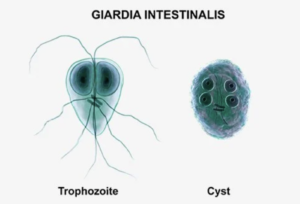GIARDIA IN PUPPIES
If you are a dog breeder then you’ll know that two of the most dangerous intestinal parasites that may affect our puppies are Giardia and Coccidia! I know I have unfortunately dealth with them before! After worms, they are the most common and can be very deadly if left untreated and so, you as a breeder will need to know how our puppies become infected with these diseases, what to do to treat them and more importantly how to prevent them from re-infecting our babies.
So what is Giardiasis?
This is essentially the most common intestinal parasitic infection of most dogs and is even more prevalent in puppies! Giardia duodenalis is a single cell protozoa to cause this. Our puppies become infected with the cyst stage of the parasite by ingesting fecal-contaminated water or food or by self grooming if their paw pads and fur is covered in feces. Some puppies may become infected eating the contaminated poop of other puppies or dogs ass well as eating contaminated grass or dirt.
Once this cyst is ingested into the body, it is converted into a trophozoite or feeding form, which then attaches itself to the intestinal wall of the puppy to start feeding and starts to grow and reproduce. They then transform into more cysts which are excreted into the feces of the pups to then continue it’s life cycle. The cycle from ingestion to shedding usually takes 5-12 days! Giardia cysts are very resilient and can live in the environment for weeks or even months- which may result in difficulty getting rid of them!

THE SIGNS AND SYMPTOMS OF A GIARDIA INFECTED PUPPY.
The most common sign of Giardia is diarrhea which is followed by a very fowl odor! Sometimes the diarrhea can consist of mucus and even blood. This may then result is a very dehydrated puppy which may then become very lethargic and weak and if left untreated may result in death. This is because Giardia will compromise the immune system of the puppy causing it to fail to thrive! Some puppies may also be asymptomatic where they do not show any signs of infection whatsoever!
HOW IS GIARDIA DIAGNOSED?
Diarrhea may be a symptoms of various other illnesses and so, to diagnoses the diseases you will have to bring your puppy to the vet along with a fresh fecal sample in a sealed bag, such as a ziploc bag.
Giardiasis may be difficult to diagnose, only because the Giardia cyst is not consistently shed in the feces, but only intermittently.
There are 2 tests that may be conducted to diagnose the disease. The primary one is done by way of fecal floatation. This is where the feces is mixed with a zinc sulfate solution which causes the cysts to float to the top which is then smeared and inspected under a microscope.
The second test which may be of a more precise test is called the ELISA test also called the SNAP test or ENZYME LINKED IMMUNO ASSAY test by detecting the presence of antigens (foreign proteins) in the stool.
NOW LET US BREAKDOWN HOW TO TREAT GIARDIA
There are 2 primary medications that may be used to irradicate the infection.
Firstly, your vet may prescribe FENBENDAZOLE which is an antiprotozoal medication such as Panacur or Safegard. These products can be bought over the counter and are also used to worm puppies 6 weeks of age or older. So it is also wise to start them on these dewormers at 6 weeks just as a preventative measure for the disease.
Then the second medication is which is more widely prescribed is METRONIDAZOLE or Flagyl. This is an antibiotic which to treat the infection is typically given over a course of anywhere between 3-10 days. If desired both medications can be used together.
Giardia is not transmissible from puppies to humans. However, there are different genotypic variations of Giardia which us as humans can contract but that calls for another video
LETS TALK PREVENTATIVE MEASURES!
Puppies can become reinfected especially if you as the breeder or owner do rid your environment of any cysts that may further contaminate your puppies food and water. Bare in mind that Giardia can survive up to months in the environment. To limit exposure and re-infection, here are some key points to note!
- Remove dog feces from your yard and kennel regularly and quickly when noticed
- Use caution when allowing your dog in outdoor spaces where other dogs may visit, such as dog parks and hiking trails
- Do not leave standing water in your yard
- Bleach and disinfectants are generally not effective in treating outdoor areas, especially grass or dirt. But use them to clean your kennels and all indoor surfaces used by your furbaby. You can also use ammonium-based disinfectants as well!
- Dont forget that the hygiene of your puppy is critical as well- clipping hair around the sanitation region, wiping with baby wipes after defecation and routine bathing are key!




